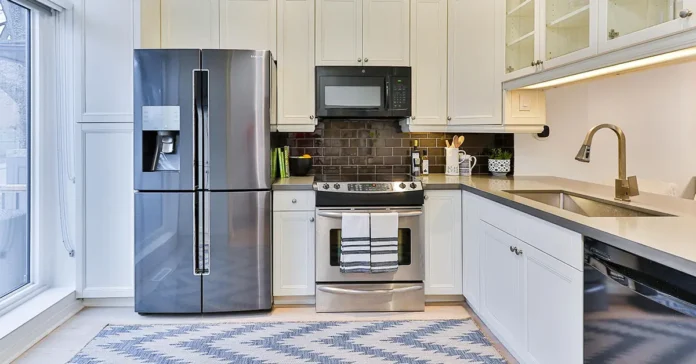Kitchen Remodeling – Welcome to the heart of your home – the kitchen. A space that not only fuels our bodies but also serves as a junction for family gatherings and culinary delights. In the quest for a homey haven, the importance of kitchen remodeling cannot be overstated. Imagine a kitchen that seamlessly blends style with functionality, where every nook and cranny is optimized to make daily tasks smooth.
From assessing current needs to planning within budget constraints, we’ll guide you through the essential must-do’s for a kitchen renovation. When it comes to kitchen renovations, the most common request is to add more storage space, but it all begins with decluttering and organizing. Get ready to unlock the potential of your cooking and create a space that meets your expectations. Let’s set the stage for a kitchen that not only looks good but works even better for you.
Kitchen Remodeling – Decluttering
Effective decluttering serves as the cornerstone for transforming your culinary space. Begin by evaluating the contents of your kitchen, identifying items that are no longer essential or functional. Clearing countertops and shelving of unnecessary clutter not only enhances visual appeal but also creates a more functional and efficient workspace.
Any home renovation project will begin with cabinets and cupboards crammed with items and appliances that are rarely used. Begin slowly. Make a clean sweep of the kitchen to declutter it. Fill three boxes as you walk through the kitchen, “Throw away, Donate, and Storage.” Open every cabinet and drawer and go through each item. You can even have a ‘Maybe’ box for items you are unsure about in the beginning.
Here are some of the items that will typically find their way into the three boxes:
- Recycle / Throw away – Mismatched plastic containers, chipped glasses, extra lids, junk drawer, stained towels, and rags.
- Donate – Mismatched glassware, extra coffee mugs and dishes, and multi-tasking utensils which will never be used but are in good condition.
- Return/Storage – Speciality baking pans, seasonal dish preparation tools and other rarely used small appliances.
After you have finished your clean sweep, go over everything again, but this time with a critical eye. Examine each category separately. If you are running out of space in your home, you can always look to rent a self-storage unit to put away all the items in your Storage box.
Design Inspirations for Kitchen Remodeling
The most desired kitchens are those that are connected to the dining room and have a central kitchen island. So, if you have the space, it is well worth the investment to open your kitchen and make it the focal point of your home. It is critical to understand the kitchen layout before embarking on a redesign. This includes available moving space, storage compartments, countertops, electronic appliance placement and more. If you have doubts before making tremendous changes to your kitchen look at these questions and make sure you can justify them to your satisfaction before moving forward:
- Do you need more counter space?
- Do you need sturdier overhead cabinets?
- Are the power outlets easily accessible?
- Can you make the drawers better or add more cabinet shelves?
- Is there adequate ventilation?
- Does the kitchen renovation cost meet your design idea?
Upgrading Kitchen Appliances for Kitchen Remodeling
It is not enough to simply have an idea of the layout and the appliances you intend to use. Look and feel, as well as durability are among the biggest reasons for upgrading kitchens. Investigate your options for appliances such as oven and hob, fridge, dishwasher, and microwave. The dimensions of your appliances will have a significant impact on the overall appearance of your kitchen, especially if you choose to go for built-in appliances. To avoid unsightly gaps, make sure all appliances fit perfectly in the space provided. Consider integrated appliances that complement your kitchen design for a seamless finish.
Keep in mind the questions below when choosing certain added features:
- Will they need special ventilation grills?
- What electrical installation are they in need of?
- Is a smoke exit needed?
- Is it safe to place it near a burner or a source of water?
Hire Professional for Small Kitchen Remodeling
Once you have decided that your kitchen needs a makeover, you must decide what needs to be changed. 89% of all homeowners hire a professional for their renovation project. When working with an interior designer or a contractor, keep in mind that aesthetics are not the only important aspects of a renovation. If you want to change the layout of your kitchen, for example, you may need to carry the plumbing, as well as the electrical and gas fittings. It is best not to try these on your own and instead seek the aid of a professional.
Your kitchen should have a balance of both functional and aesthetically pleasing aspects. Here are some tips to help you achieve a balance of both:
- If you are expanding your kitchen, add more countertops. This allows you to spread out your belongings without them looking cluttered. Everything that is not tucked away on a shelf may need its own spot on the counter.
- Consider pull-out counters if you have a small kitchen with no room for expansion. These add a modern touch to your kitchen while being still functional.
- Place all electrical appliances near a power outlet. This reduces the amount of visible wiring.
- Choose stain-resistant tiles and countertops because you know there will be spills and splashes all the time. Oil smears and curry stains are an irritant to the eyes. You do not want to spend hours scrubbing them away.
Safety and Durability
No matter how large or small the renovation project is, it will take time. You will be unable to use your kitchen during the renovation, which may cause chaos. Keep your mind on the goal and trust in the process. All changes must be carried out by the builders while adhering to all safety precautions. Before giving the green light, carefully rethink each design change. Select materials that are long-lasting and resistant to wear and tear. Everything from the tiles to the panels to the electrical fixtures, sinks, chimneys, countertops, handles, and hinges must be of the highest quality and safety. While you may want everything to be one-of-a-kind, replacements must be readily available if something is damaged!
Before and After Showcase
Explore real-life stories of kitchen makeovers that highlight the positive changes made by following the essential must-do’s. One, hear from homeowners who faced challenges like small spaces and outdated designs, discovering how they overcame these issues with smart solutions. Second, see the transformations in easy-to-understand before and after pictures, showcasing the improvements from cluttered to organized, outdated to modern, and dim to well-lit spaces.
Lastly, learn from these stories how each essential must-do, like upgrading appliances or adding personal touches, can make a real difference. The Before and After Showcase not only celebrates successful kitchen renovations but also shows you how careful planning and simple steps can bring positive changes to your own kitchen space.
Final Words
From meticulous planning and budgeting to adapt innovative designs, each step plays a pivotal role in remodeling your kitchen into a functional and aesthetically pleasing hub. There are times when no matter how hard you try to save money to achieve your dream kitchen, you are unable to do so. In such cases, rather than completing the renovation all at once, consider refurbishing your kitchen in stages. You can, for example, change the lighting and flooring in the kitchen at one time and then add new paint and furniture at another. Remodeling in stages will allow you to save enough money for each step of the process. Second, it will give you enough time to think about your decisions and renovation ideas!
FAQs
A: Kitchen renovation is crucial for creating a functional and aesthetically pleasing space that meets your needs and enhances the overall value of your home.
A: Assess your priorities, set a realistic budget, and consider factors like materials, labor costs, and unexpected expenses.
A: The five essential must-do’s include upgrading appliances, optimizing storage, using energy-efficient practices, enhancing lighting, and adding personal touches.
A: Yes, certain projects lend themselves to DIY, but it’s crucial to evaluate your skills and know when to bring in professionals for more complex tasks.
A: Seek recommendations, read reviews, and ask for references. Ensure the contractor is licensed, insured, and experienced in kitchen renovations.
A: Explore popular trends such as open shelving, sustainable materials, and smart appliances. However, prioritize timeless elements that align with your personal style.
A: The timeline varies based on the scope of the project. Simple renovations might take a few weeks, while more extensive ones could span several months.
A: Regular cleaning, proper maintenance of appliances, and addressing issues promptly will contribute to the longevity of your renovated kitchen.







